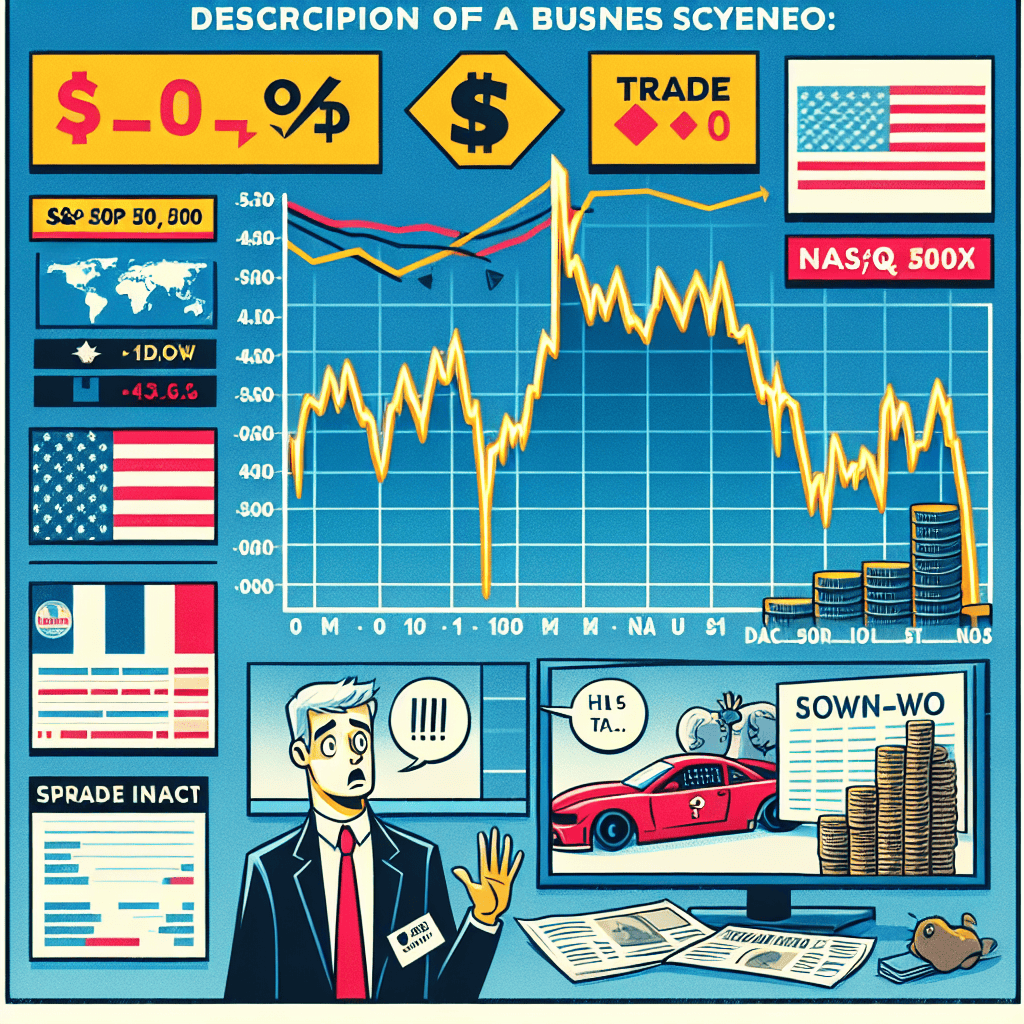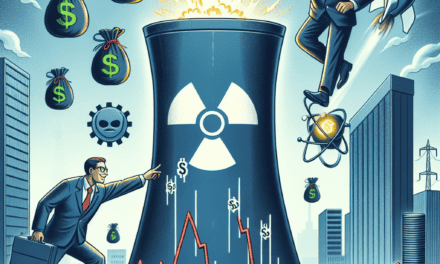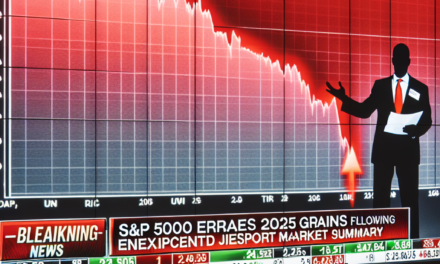“Market Shaken: Iowa’s Surprise Sends Dow, S&P 500, Nasdaq Tumbling Amid Trump Trade Turmoil”
Introduction
In a surprising turn of events, the financial markets experienced a notable downturn as the Dow Jones Industrial Average, S&P 500, and Nasdaq Composite all registered declines. This market shift comes in the wake of unexpected developments in Iowa that have significantly impacted the so-called “Trump Trade,” a term used to describe the market trends and economic policies associated with former President Donald Trump. The unforeseen events in Iowa have introduced a new layer of uncertainty, prompting investors to reassess their strategies and leading to a ripple effect across major stock indices. As market participants digest the implications of these developments, the focus now shifts to understanding the broader economic and political ramifications that could influence future market dynamics.
Analysis Of The Dow’s Reaction To Iowa’s Influence On Trump Trade
In recent developments, the financial markets have experienced notable fluctuations, with the Dow Jones Industrial Average, the S&P 500, and the Nasdaq Composite all registering declines. This downturn can be attributed to an unexpected influence stemming from Iowa, which has had a significant impact on the so-called “Trump trade.” To understand the intricacies of this market reaction, it is essential to delve into the factors at play and how they have collectively influenced investor sentiment.
The “Trump trade” refers to the market trends and economic policies associated with former President Donald Trump, which have historically been characterized by deregulation, tax cuts, and a focus on domestic manufacturing. These policies have often been met with enthusiasm by investors, leading to bullish market behavior. However, recent events in Iowa have introduced a new layer of complexity to this dynamic, causing investors to reassess their positions.
Iowa, traditionally known for its agricultural output and as a bellwether in political primaries, has recently become a focal point due to unexpected policy shifts and economic indicators. These developments have raised concerns about the stability and predictability of the Trump trade, prompting investors to reevaluate their strategies. The state’s influence on agricultural markets, particularly in commodities such as corn and soybeans, has had a ripple effect on related industries and, by extension, the broader market.
Moreover, Iowa’s impact is not limited to agriculture alone. The state’s recent policy changes have also affected manufacturing and trade sectors, which are integral components of the Trump trade. As a result, companies with significant exposure to these industries have faced increased volatility, leading to a broader market sell-off. This has been particularly evident in the Dow Jones Industrial Average, which includes several major manufacturing firms.
In addition to these sector-specific influences, Iowa’s unexpected impact has also introduced a degree of political uncertainty. As a key state in the electoral process, any shifts in its economic landscape can have broader implications for national policy and investor confidence. This uncertainty has been further compounded by ongoing debates over trade agreements and tariffs, which have been central to the Trump administration’s economic agenda.
As investors grapple with these multifaceted challenges, the declines in the S&P 500 and Nasdaq Composite reflect a broader reevaluation of risk. Technology stocks, which have been a driving force behind market gains in recent years, have also been affected by the shifting landscape. Concerns over supply chain disruptions and regulatory changes have contributed to a more cautious approach among investors, leading to a pullback in these indices.
In conclusion, the recent declines in the Dow, S&P 500, and Nasdaq can be attributed to the unexpected influence of Iowa on the Trump trade. This development has introduced new uncertainties into the market, prompting investors to reassess their strategies and adjust their portfolios accordingly. As the situation continues to evolve, it will be crucial for market participants to remain vigilant and adaptable, navigating the complexities of an ever-changing economic and political landscape. Through careful analysis and strategic decision-making, investors can better position themselves to weather the challenges and capitalize on potential opportunities that may arise in the future.
S&P 500’s Unexpected Decline: Iowa’s Role In Market Dynamics
The recent downturn in the S&P 500, alongside declines in the Dow and Nasdaq, has captured the attention of investors and analysts alike, as unexpected developments in Iowa have introduced new variables into the already complex landscape of market dynamics. Traditionally, the S&P 500 serves as a barometer for the overall health of the U.S. economy, reflecting the performance of 500 of the largest companies listed on stock exchanges in the United States. However, the recent decline has prompted a closer examination of the factors at play, particularly the surprising influence of Iowa on the Trump trade policies.
To understand the current market situation, it is essential to consider the broader context of the Trump trade policies, which have been a significant driver of market sentiment since their inception. These policies, characterized by a focus on protectionism and renegotiation of trade agreements, have had a profound impact on various sectors, including agriculture, manufacturing, and technology. Iowa, a state with a robust agricultural sector, has been particularly affected by these policies, as tariffs and trade tensions have disrupted traditional supply chains and export markets.
The unexpected impact of Iowa on the markets can be attributed to several key developments. Firstly, recent reports indicate that Iowa’s agricultural output has been adversely affected by ongoing trade disputes, leading to a ripple effect across related industries. This has raised concerns among investors about the potential for broader economic repercussions, particularly in states with similar economic profiles. As a result, market participants have become increasingly cautious, leading to a sell-off in stocks that are perceived to be vulnerable to these disruptions.
Moreover, Iowa’s political landscape has also played a role in shaping market dynamics. As a key battleground state, Iowa’s stance on trade policies can influence national political discourse, potentially affecting the direction of future trade negotiations. Recent political developments in Iowa have signaled a shift in sentiment, with growing calls for a reevaluation of current trade strategies. This has introduced an element of uncertainty into the markets, as investors grapple with the potential implications of policy changes on corporate earnings and economic growth.
In addition to these factors, the broader economic environment has also contributed to the decline in the S&P 500. Concerns about inflation, interest rates, and global economic growth have created a challenging backdrop for equities, exacerbating the impact of Iowa-related developments. As central banks around the world navigate the delicate balance between supporting growth and curbing inflation, market volatility has increased, prompting investors to reassess their risk exposure.
Despite these challenges, it is important to note that the market’s response to Iowa’s impact on the Trump trade policies is not entirely negative. Some sectors, such as technology and renewable energy, have shown resilience, as investors seek opportunities in areas less affected by trade tensions. Furthermore, the current market environment has prompted companies to explore new strategies for mitigating risk, such as diversifying supply chains and investing in innovation.
In conclusion, the unexpected decline in the S&P 500, driven in part by developments in Iowa, underscores the complex interplay of factors influencing market dynamics. As investors navigate this evolving landscape, it is crucial to remain informed and adaptable, recognizing that the path forward may be shaped by both domestic and global forces. By understanding the nuances of these influences, market participants can better position themselves to capitalize on opportunities and manage risks in an uncertain environment.
Nasdaq’s Response To Iowa’s Impact On Trump Trade Policies
In recent developments, the financial markets have experienced a notable downturn, with the Dow Jones Industrial Average, S&P 500, and Nasdaq Composite all registering declines. This downturn has been attributed to an unexpected impact originating from Iowa, which has significantly influenced the Trump administration’s trade policies. As investors and analysts attempt to decipher the implications of these developments, the Nasdaq’s response to the situation has been particularly noteworthy.
The Nasdaq, known for its heavy concentration of technology and growth-oriented companies, has shown a distinct sensitivity to trade policy shifts. This sensitivity is largely due to the global nature of the technology sector, where supply chains and market access are intricately linked to international trade agreements. Consequently, any disruption or uncertainty in trade policies can have a pronounced effect on the performance of Nasdaq-listed companies. The recent developments in Iowa have introduced a new layer of complexity to the already intricate trade landscape, prompting a reassessment of market strategies.
Iowa, a state with a significant agricultural output, plays a crucial role in the United States’ trade dynamics, particularly in relation to agricultural exports. The unexpected impact from Iowa has stemmed from a combination of factors, including adverse weather conditions affecting crop yields and shifts in international demand for U.S. agricultural products. These factors have, in turn, influenced the Trump administration’s trade policies, as the need to address domestic agricultural concerns has become more pressing. As a result, there has been a recalibration of trade priorities, which has introduced a degree of uncertainty into the market.
The Nasdaq’s response to these developments has been characterized by heightened volatility, as investors grapple with the potential implications for technology companies. Many of these companies rely on stable trade relations to maintain their supply chains and access to international markets. The uncertainty surrounding trade policies has led to fluctuations in stock prices, as market participants attempt to gauge the long-term impact on corporate earnings and growth prospects. In this context, the Nasdaq’s performance serves as a barometer for investor sentiment regarding the broader economic implications of trade policy shifts.
Moreover, the Nasdaq’s response is also reflective of broader market trends, as investors seek to navigate an increasingly complex global economic environment. The interplay between domestic policy decisions and international trade dynamics has become a focal point for market participants, who are keenly aware of the potential for policy shifts to influence economic growth and corporate profitability. As such, the Nasdaq’s performance is not only indicative of the immediate impact of Iowa’s influence on trade policies but also of the broader challenges facing the global economy.
In conclusion, the recent decline in the Nasdaq, alongside the Dow and S&P 500, underscores the intricate relationship between domestic developments and international trade policies. The unexpected impact from Iowa has introduced a new dimension to the Trump administration’s trade strategy, prompting a reassessment of market conditions. As investors and analysts continue to monitor these developments, the Nasdaq’s response will remain a key indicator of market sentiment and the potential implications for the technology sector. Through this lens, the current market dynamics highlight the importance of understanding the interconnectedness of domestic and international economic factors in shaping financial market outcomes.
Iowa’s Influence On Trump Trade: A Comprehensive Market Overview

In recent developments, the financial markets have experienced notable fluctuations, with the Dow Jones Industrial Average, S&P 500, and Nasdaq Composite all registering declines. This downturn can be attributed to an unexpected factor: the impact of Iowa’s political landscape on the Trump trade policies. As investors navigate these turbulent waters, it is crucial to understand the underlying dynamics that have led to this market response.
To begin with, Iowa has long been recognized as a bellwether state in American politics, often setting the tone for national policy directions. Recently, political shifts within Iowa have raised concerns about the sustainability of certain trade policies championed by former President Donald Trump. These policies, which include tariffs and renegotiated trade agreements, have been pivotal in shaping the economic landscape over the past few years. However, as Iowa’s political climate evolves, questions arise regarding the future of these policies and their implications for the broader market.
The agricultural sector, a cornerstone of Iowa’s economy, has been particularly affected by these trade policies. Farmers in the state have expressed growing unease over the tariffs imposed on key trading partners, which have led to retaliatory measures and disrupted traditional supply chains. This discontent has translated into political pressure, prompting local leaders to advocate for a reevaluation of existing trade agreements. Consequently, investors are now grappling with the potential for policy reversals or modifications, which could significantly alter the economic landscape.
Moreover, the uncertainty surrounding Iowa’s influence on trade policy has reverberated through the financial markets, contributing to the recent declines in major indices. Investors, wary of potential disruptions to established trade relationships, have adopted a more cautious stance. This shift in sentiment is reflected in the performance of the Dow, S&P 500, and Nasdaq, as market participants reassess their portfolios in light of these developments.
In addition to the direct impact on trade policy, Iowa’s political shifts have broader implications for the U.S. economy. The state plays a critical role in the production of key commodities, such as corn and soybeans, which are integral to both domestic and international markets. Any changes in trade policy could have cascading effects on these industries, influencing everything from pricing to global supply chains. As a result, investors are closely monitoring the situation, seeking to anticipate potential outcomes and adjust their strategies accordingly.
Furthermore, the current market environment is characterized by heightened volatility, as investors weigh the potential risks and rewards associated with these developments. While some market participants remain optimistic about the prospects for a favorable resolution, others are more cautious, opting to reduce their exposure to sectors that may be adversely affected by changes in trade policy. This divergence in investor sentiment underscores the complexity of the current market landscape and highlights the importance of staying informed about evolving political and economic dynamics.
In conclusion, the recent declines in the Dow, S&P 500, and Nasdaq can be largely attributed to the unexpected influence of Iowa’s political landscape on Trump trade policies. As investors navigate this uncertain environment, it is essential to remain vigilant and informed about the potential implications for both domestic and global markets. By understanding the interconnectedness of political developments and economic outcomes, market participants can better position themselves to respond to future challenges and opportunities.
The Ripple Effect: How Iowa’s Impact Affected Major U.S. Indices
In recent developments, the major U.S. stock indices, namely the Dow Jones Industrial Average, the S&P 500, and the Nasdaq Composite, have experienced a notable decline. This downturn can be attributed to an unexpected impact originating from Iowa, which has had a ripple effect on the broader market, particularly concerning the Trump trade policies. As investors and analysts attempt to decipher the implications of this unforeseen event, it is crucial to understand the interconnectedness of regional developments and their potential to influence national and global markets.
The state of Iowa, often recognized for its agricultural prowess, plays a significant role in the U.S. economy. Its influence extends beyond its borders, particularly in sectors such as agriculture, manufacturing, and renewable energy. Recently, Iowa has been at the center of a policy shift that has caught the attention of investors. This shift pertains to trade policies that were initially championed by the Trump administration, which aimed to bolster American industries through tariffs and renegotiated trade agreements. However, the latest developments in Iowa suggest a deviation from these policies, leading to uncertainty in the markets.
The impact of Iowa’s policy shift is multifaceted. Firstly, it has raised concerns about the stability of trade agreements that were previously thought to be settled. This uncertainty has led to a reassessment of risk among investors, who are now questioning the long-term viability of these agreements. As a result, there has been a sell-off in stocks that are heavily reliant on international trade, contributing to the decline in the major indices. Furthermore, Iowa’s influence on agricultural exports cannot be understated. The state is a significant producer of corn and soybeans, commodities that are crucial to trade agreements with countries such as China. Any disruption in these exports can have a cascading effect on related industries, thereby affecting the overall market sentiment.
In addition to trade concerns, the policy shift in Iowa has also sparked debates about the future of renewable energy investments. Iowa is a leader in wind energy production, and any changes in policy could have implications for the renewable energy sector. Investors are closely monitoring these developments, as they could signal a broader shift in energy policy at the national level. This uncertainty has contributed to the volatility in the stock market, as investors seek to reposition their portfolios in anticipation of potential changes.
Moreover, the decline in the major indices is not solely attributed to Iowa’s impact. It is essential to consider the broader economic context, including inflationary pressures, interest rate hikes, and geopolitical tensions, which have already been weighing on investor sentiment. The unexpected developments in Iowa have merely added another layer of complexity to an already challenging investment landscape.
In conclusion, the recent decline in the Dow, S&P 500, and Nasdaq can be traced back to an unexpected impact from Iowa, which has raised questions about the future of trade policies and renewable energy investments. As investors navigate this uncertain environment, it is crucial to remain vigilant and adaptable to changing market conditions. The interconnectedness of regional developments and their potential to influence national and global markets underscores the importance of a comprehensive approach to investment strategy. As the situation continues to evolve, market participants will need to stay informed and responsive to new information, ensuring that they are well-positioned to manage risk and capitalize on emerging opportunities.
Understanding The Market’s Reaction To Iowa’s Unexpected Influence
In recent developments, the financial markets have experienced a notable downturn, with the Dow Jones Industrial Average, the S&P 500, and the Nasdaq Composite all registering declines. This unexpected shift has been attributed to unforeseen political developments in Iowa, which have had a ripple effect on the broader economic landscape, particularly concerning the Trump administration’s trade policies. Understanding the market’s reaction to these events requires a closer examination of the intricate interplay between politics and economic sentiment.
Initially, it is essential to recognize that financial markets are highly sensitive to political events, especially those that could potentially alter trade dynamics. The Trump administration’s trade policies have been a focal point for investors, given their significant implications for international commerce and economic growth. Therefore, any political developments that could influence these policies are closely monitored by market participants. In this context, the unexpected political developments in Iowa have introduced a new layer of uncertainty, prompting investors to reassess their positions.
The situation in Iowa has raised questions about the stability and future direction of the Trump administration’s trade agenda. As Iowa holds a unique position in the American political landscape, often serving as a bellwether for broader national trends, developments in this state can have outsized impacts on political calculations. Consequently, the unexpected political shifts in Iowa have led to speculation about potential changes in trade policy, which, in turn, have unsettled the markets.
Moreover, the decline in the major indices can also be attributed to the broader context of global economic uncertainty. Trade tensions have been a persistent source of volatility in recent years, and any indication of further instability can exacerbate market anxieties. Investors, already on edge due to ongoing trade disputes and geopolitical tensions, may have viewed the developments in Iowa as a catalyst for further uncertainty, prompting a sell-off in equities.
In addition to these factors, it is important to consider the role of investor psychology in market movements. Financial markets are not solely driven by economic fundamentals; they are also influenced by the collective sentiment of market participants. When unexpected political events occur, they can trigger a shift in investor sentiment, leading to increased volatility. In this case, the developments in Iowa may have heightened concerns about the predictability of future trade policies, leading investors to adopt a more cautious stance.
Furthermore, the decline in the Dow, S&P 500, and Nasdaq can be seen as part of a broader trend of market sensitivity to political developments. In recent years, markets have become increasingly reactive to political news, reflecting the growing interconnectedness of politics and economics. This trend underscores the importance of staying informed about political developments and their potential economic implications.
In conclusion, the recent decline in major U.S. stock indices following unexpected political developments in Iowa highlights the intricate relationship between politics and financial markets. As investors navigate this complex landscape, they must remain vigilant in assessing the potential impacts of political events on economic policies and market sentiment. By understanding the factors driving market reactions, investors can better position themselves to respond to future developments, ensuring that they are prepared for the challenges and opportunities that lie ahead.
The Intersection Of Politics And Markets: Iowa’s Impact On Trump Trade
In recent developments, the financial markets have experienced a notable downturn, with the Dow Jones Industrial Average, S&P 500, and Nasdaq Composite all registering declines. This market movement has been largely attributed to unexpected political developments in Iowa, which have had a ripple effect on what is commonly referred to as the “Trump Trade.” The Trump Trade, a term coined to describe the market trends and economic policies associated with the administration of former President Donald Trump, has been a significant driver of market sentiment and investment strategies since its inception. However, the recent political events in Iowa have introduced a new layer of uncertainty, prompting investors to reassess their positions.
The political landscape in Iowa has shifted in a manner that was unforeseen by many market analysts. This shift has raised questions about the stability and future direction of policies that were once considered cornerstones of the Trump administration’s economic agenda. As a result, investors are now grappling with the potential implications of these changes on trade policies, regulatory frameworks, and overall economic growth. The uncertainty surrounding these issues has led to a cautious approach among market participants, contributing to the observed declines in major stock indices.
Moreover, the impact of Iowa’s political developments extends beyond domestic markets, influencing global economic dynamics as well. International investors, who have been closely monitoring U.S. political developments, are now reevaluating their exposure to American markets. This reevaluation is driven by concerns over potential shifts in trade agreements and foreign policy stances that could arise from the evolving political situation. Consequently, the interconnectedness of global markets means that the reverberations of Iowa’s impact are being felt across borders, adding another layer of complexity to the current market environment.
In addition to the direct effects on market indices, the Iowa developments have also influenced investor sentiment more broadly. The heightened uncertainty has led to increased volatility, as market participants seek to navigate the evolving landscape. This volatility is reflected in fluctuating asset prices and a general sense of caution that pervades trading activities. Investors are now more inclined to adopt defensive strategies, prioritizing assets that are perceived as safe havens in times of uncertainty, such as gold and government bonds.
Furthermore, the intersection of politics and markets is not a new phenomenon, but the current situation underscores the profound impact that political developments can have on economic conditions. The Iowa case serves as a reminder of the intricate relationship between policy decisions and market outcomes. It highlights the need for investors to remain vigilant and adaptable, as political events can swiftly alter the trajectory of market trends.
In conclusion, the recent declines in the Dow, S&P 500, and Nasdaq underscore the significant influence of political developments on financial markets. The unexpected impact of Iowa’s political landscape on the Trump Trade has introduced a new wave of uncertainty, prompting investors to reassess their strategies and adapt to the evolving environment. As the situation continues to unfold, market participants will need to remain attentive to both domestic and international political developments, recognizing their potential to shape economic conditions and market dynamics in profound ways.
Q&A
1. **What caused the market decline?**
The market decline was caused by an unexpected impact from Iowa on the Trump trade.
2. **Which major indices were affected?**
The Dow Jones Industrial Average, S&P 500, and Nasdaq Composite were all affected.
3. **What is the Trump trade?**
The Trump trade refers to market movements and investor strategies based on policies and expectations associated with Donald Trump’s presidency.
4. **How did the Dow perform?**
The Dow Jones Industrial Average declined following the unexpected Iowa impact.
5. **What was the impact on the S&P 500?**
The S&P 500 experienced a decline as a result of the unexpected Iowa impact.
6. **How did the Nasdaq react?**
The Nasdaq Composite also saw a decline due to the unexpected Iowa impact.
7. **What was the unexpected Iowa impact?**
The specific details of the unexpected Iowa impact were not provided, but it influenced market sentiment and led to declines in major indices.
Conclusion
The unexpected impact of developments in Iowa on the Trump trade has led to declines in major U.S. stock indices, including the Dow, S&P 500, and Nasdaq. This market reaction reflects investor uncertainty and potential reevaluation of economic policies associated with the Trump administration. The declines suggest that geopolitical and domestic political events continue to play a significant role in influencing market sentiment and investor confidence. As a result, market participants may need to adjust their strategies to account for increased volatility and potential shifts in policy direction.





